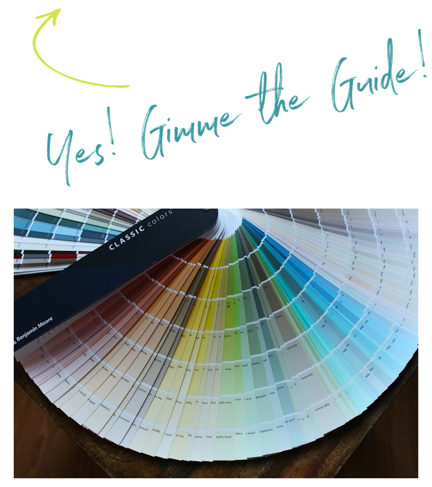Dear Laurel,
I’m hoping that you can turn this into a post. It’s about my new area rug.
It’s for our large living/great room.

This is the look I was going for. I love your Mark D. Sikes post, especially the high-low post.
Here are some more rooms that I love.
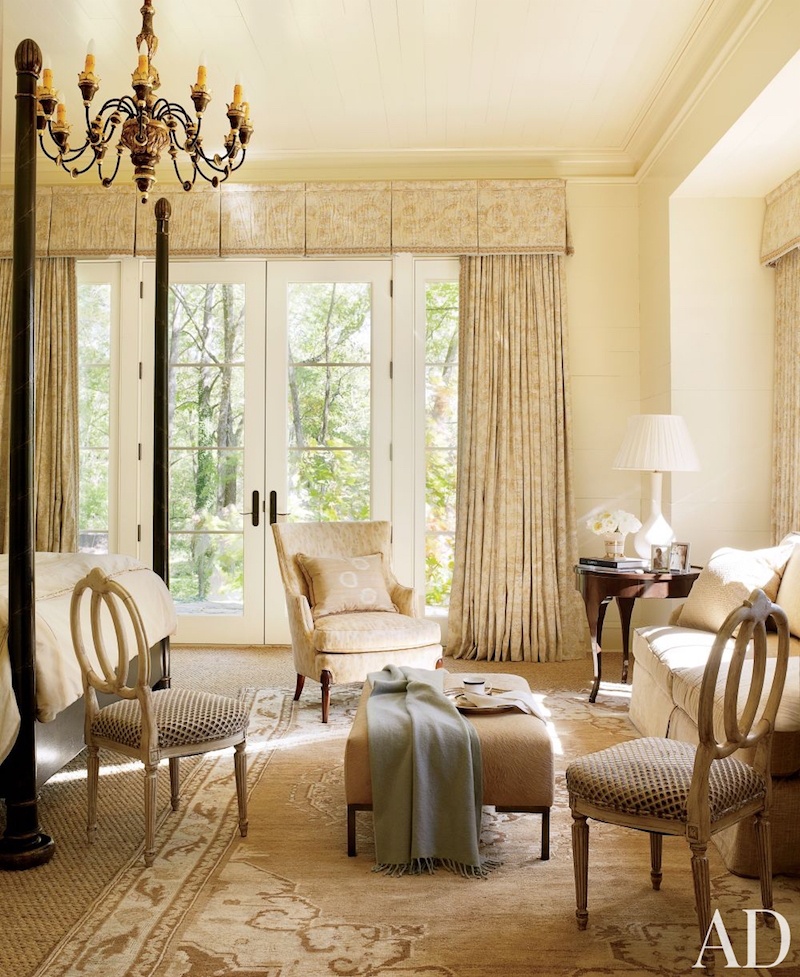
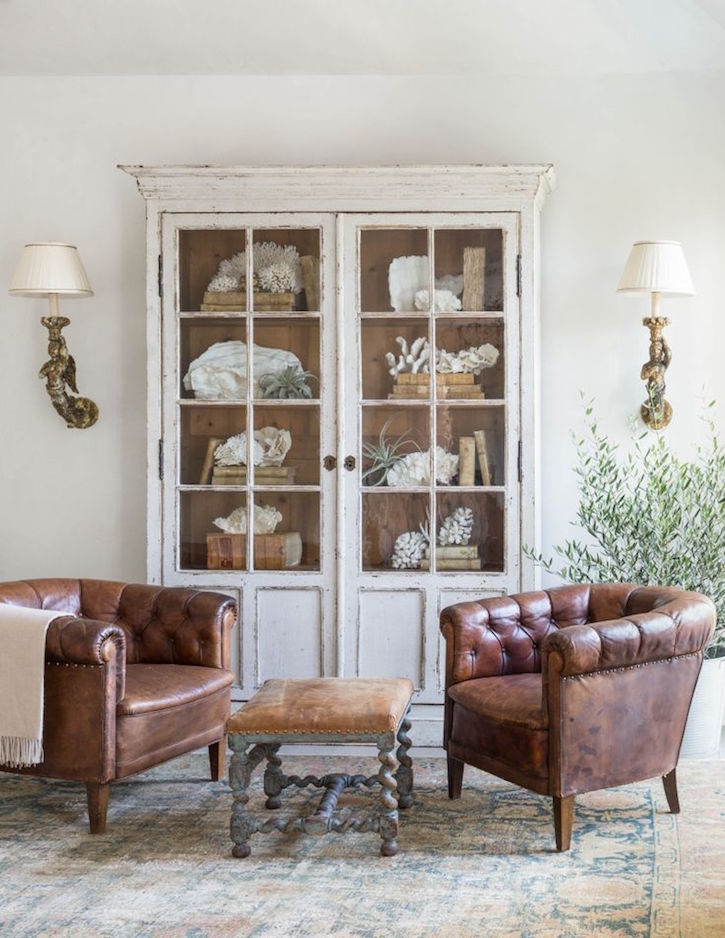
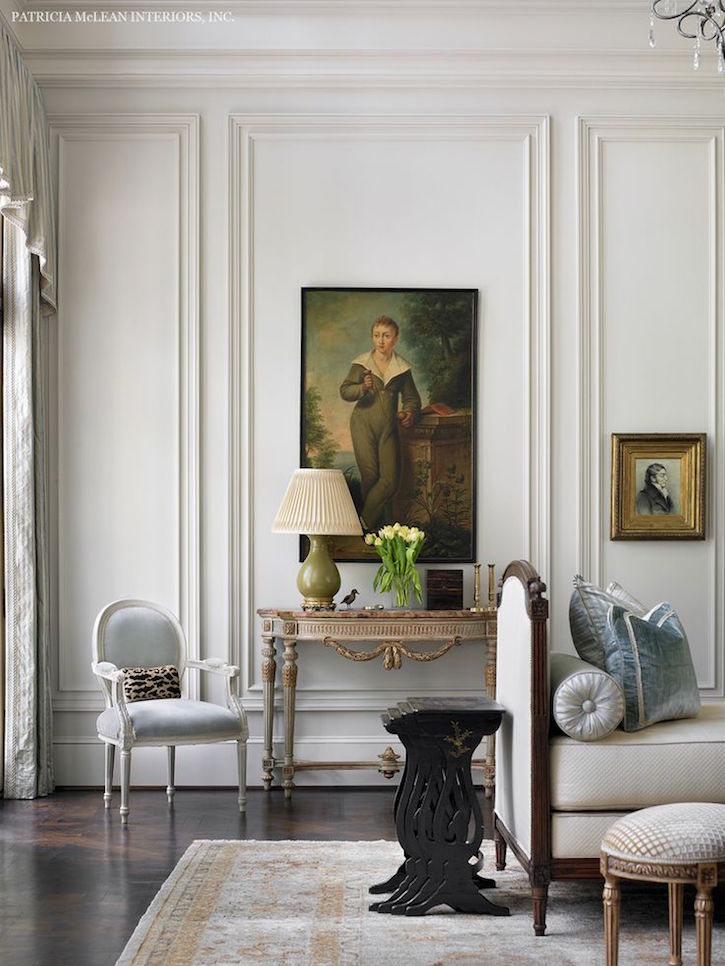
I hired a decorator to help me achieve this in my 16′ x 20′ living/great room. (not Patricia McLean. I wish!)
She seemed nice enough, but she’s only been in business for two years and I should’ve hired someone with more experience. When I showed her these images, she said she had never heard of layering an oriental over a seagrass rug. She said it would get wrecked.
Since people like Mark D. Sikes and Suzanne Kasler are layering fine oriental rugs over seagrass, I doubt that’s true.
My tale of woe.
In the end, we did a custom area rug, cut from broadloom. It was quite expensive and while it looked fine in the 12″ x 18″ sample, it is very different in a 14′ x 18′ area rug!
And Laurel, I hate it. I hate this area rug.
And there’s a big fat seam because the broadloom is only 12 feet wide. I was told that it would hardly be noticeable if at all.
Ha! That’s a crock! You can see it before you even enter the room!
Where did we go wrong? And how on earth am I going to fix this?
I’m so upset. I let that woman talk me into getting this rug, saying I needed to step out of my “comfort zone” and said it would be “fabulous.”
She waltzed in yesterday, wide-eyed as can be, and guess what she said?
“FABULOUS!!!”
When I told her I was quite unhappy with the rug, she looked at me like I had just told her that her baby was fat and ugly. (He kind of is, but I would never say that.)
“Oh, you just need to adjust to having something new in the room,” she said.
I see… Well, I guess she will need to adjust to the fact that I’m firing her.
Thanks for any insight you can provide. Hopefully, there’s something here that will be of interest to other readers.
Patricia Mashad
***
Hi Laurel,
I’m a long-time reader and searching for a post on layering rugs. After 30 years our dark oriental has made its way out, and now I have a room-expanding sisal.
I want to layer another oriental area rug over the large, 12′ x 18′ sisal rug, but I don’t know where to begin. There is the “Tara” blog with area rugs that coordinate, (and layering) but what size is appropriate? A blog on the subject would be helpful.
Sincerely,
Suzie
***
Hi everyone. I’ve written a fair amount about area rugs with different emphases.
You can find the other rug posts by clicking here.
This one is more technical in terms of what sizes, as well as rules when layering rugs. We’ll review how much floor margin is required, whether wood or another flooring.
In both cases, the rooms are a little larger than the average living room. However, these principles apply to rooms of all sizes. Although very small rooms might be a little different.
Let’s begin with Patricia’s situation; did she need a custom area rug?
Probably not.
Her room is quite deep, and when I have a room that’s really big and square-ish and deep, I always float the sofa. Always. For some common living room layouts for an average-sized living room, please check out this post.
So, in all likelihood, a 10′ x 14′ standard-size rug would’ve been lovely. There are even larger area rugs than that. However, a 10′ x 14′ is a big rug.
And then again, she could’ve done a smaller area rug and layered it over seagrass or jute, like Mark’s rug in his showhouse room.
At the moment, she has a rug that she hates. I don’t know if the furniture is back in the room, if the balance is off, or what the issue is.
First, I would live with it for a few weeks because sometimes there is an adjustment period when you get something new, and it’s a big thing.
But I would never put it the way her decorator did!
Alas, sometimes all one can do is cut their losses and try to sell the rug, put it in the basement, or give it to charity.
Still, none of those options might work, but maybe a big smashing coffee table will help. Or, a different color on the wall, pillows, art, plants, or accessories. Again, I can’t advise since I can’t see the room.
The rest of this post will focus more on what we might do in specific situations when putting an area rug in a living-type room.
Although, I have a few words for Suzie that we all need to hear, including myself.
I will begin with some common myths about choosing an area rug.
Myth #1
All area rugs should be 12″ away from the wall.
While sometimes it is a good rule of thumb to leave a one-foot margin of wood around the room, that is often not the case.
In fact, for many rooms, a one-foot margin would be horrible.
There are numerous aspects to consider when choosing the appropriate size area rug for a space.
- What size is the room?
- Is there furniture lining the perimeter of the room?
- What about traffic patterns? This is super important when selecting an area rug size because a huge no-no is having to walk half on and half off an area rug. There should be a minimum of two feet of either rug or floor to walk on. Although, all major traffic paths should be at least three-feet wide.
- What style of rug are you planning to use? A plain or textured rug or one with a simple pattern can go larger than a bold, intense one. That one is a general rule of thumb. There may be exceptions.However, darling Suzie, if you’re within eye-shot, I’m afraid I’m going to have to lovingly give you a virtual light clop on the tuchus with my imaginary T-square. ;] ;] ;]
- Why? It’s because you said you’ve been reading for a while, but don’t know where to begin.
Well, that can’t be. If you’ve been reading for a while, you do know where to begin.
Please begin by (re)reading the 12-step decorating plan. :] This is a post I should not be giving away for free. Of course, it’s fine. It’s the most important post in this entire volume of blog posts that spells out the steps one needs to take when furnishing a room. Or, designing a space.
There are no shortcuts.
You may have seen or heard about what it takes to separate conjoined twins. It takes months of planning, and preparing the twins for the surgery. They don’t just throw the babies on the operating table and hope for the best.
Yet, effectively, that’s what most people do when they shop for furniture. They do it ad hoc. And, unless one has a super-strong vision of what they want, it is more often than not, a disaster.
First, you need to decide what furniture you need and then, what size and where it will be placed in the room.
Only after you’ve done that can you figure out what size area rug you’ll need.
I have created 100s of living, family, and great room floor plans since 1988, and every time, the last thing I select is the area rug. The only exception was when I had to work with a client’s existing rug.
Myth number two is that all legs of the furniture must be sitting on the area rug.
That is definitely not true.
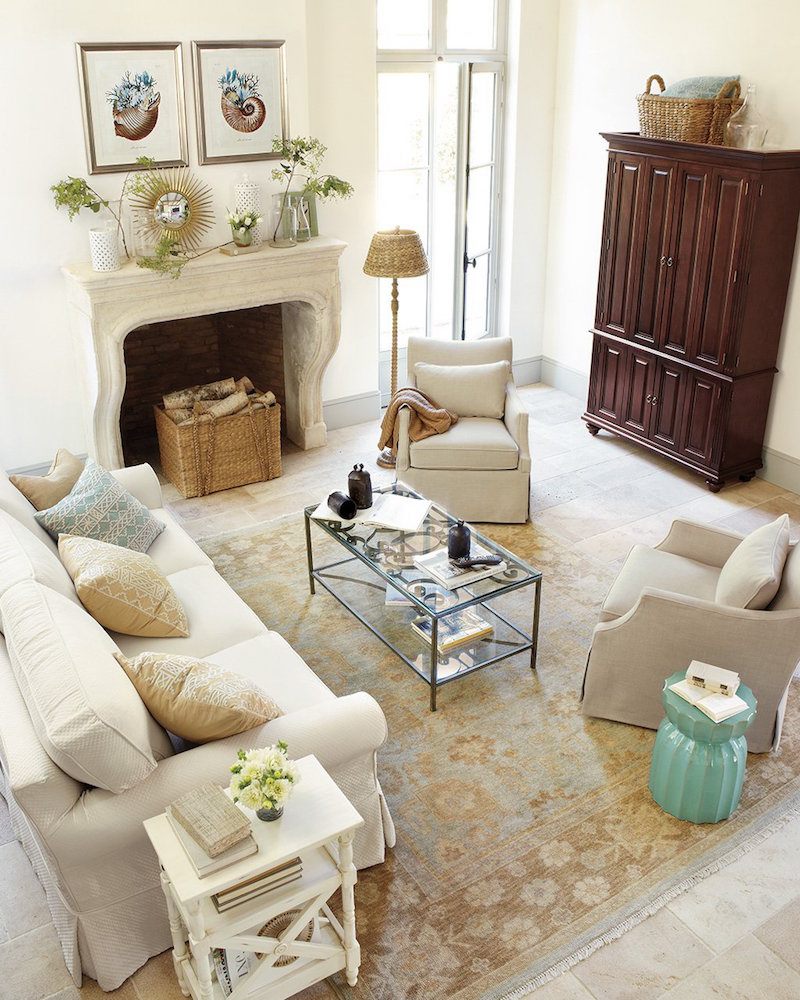
Suzanne Kasler for Ballard Designs
- One thing to avoid is having case pieces, tables, and dining chairs, half on and half off an area rug. It should be one way or the other. The only exception is if it’s a flatweave rug with a thin latex rug pad. Then, we’re only talking about a quarter of an inch in thickness. In this case, it’s okay if some pieces are half on and half off. For a sofa or club chair, it is okay for any piece to be partially on and partially off the area rug.
Suppose you have a very small room with a lot of built-ins. We might do an area rug and only leave 6″-8″ of wood margin showing. Or, you could do wall-to-wall carpeting using seagrass, or a tailored tight-weave wool, synthetic or blend, broadloom. This is a terrific solution for a tiny office or super small bedroom. I shared a few possibilities in last Sunday’s granny decor mistakes post.
Let’s focus on layering area rugs.
Those fantastic examples above show beautiful oriental rugs layered over a natural fiber rug. The most common natural fiber rugs used are seagrass, sisal, and jute.
Will the fine hand-knotted oriental rug get wrecked?
It won’t if put a rug pad underneath the Oriental rug. If it’s an extremely fine or fragile oriental rug, you might consider taking it to a fabricator to have a fabric backing hand sewn on the underneath side– at least around the edges. This is because the pad needs to be an inch or two smaller than the oriental rug so it doesn’t show.
What kind of pad? I would do a fairly thin latex pad. It only needs to prevent chafing from the coarse natural fiber. You will want a rug pad underneath the natural fiber rug with a great grip. I would consult with your installer. There are numerous brands, and most are fine. One I used to use was durahold.
And yes, I recommend that a large rug of any kind, unless it’s a lightweight flatweave, is professionally installed.
Of course, you don’t have to, but if there’s already furniture in the room, they can work around it because they have techniques to do so.
It’s time for a story about a time I seriously screwed up, and of course, it was for a client. If you’re not interested in reading it, please skip to here.***
We need to go back in time to the year 2000. I had seen in a magazine that a designer had taken three wide-fabric-bound seagrass rugs and butted them together to make one big rug.

It was very much like in Mark D Sike’s showhouse room; only this is jute instead of seagrass. If you look closely, under the chair, you can see where two rugs are flush, next to each other.
I thought, “how cool!” And my client liked the idea too.
So, that’s what we did. I had made for her three 6 feet x 18 feet area rugs.
I was there for installation day.
The installer was concerned that the rugs would slip and thought he should put some heavy-duty double-stick tape underneath the rug pad. That would keep everything nicely in one spot.
I had figured that the heavy furniture and the non-skid rug pad would be enough. But, he said no.
I said, “okay.”
After all, he was the expert.
This was one of the biggest jobs in my career. I touched every room in the house in one way or another. This new great room was formerly the garage. So, everything was new, but had been drying for a few weeks.
We did the installation, and everything looked fantastic!
Fast forward a couple of months later.
I was at the house, again, and the client, who was as nice as can be. Said that something was wrong with the rugs. They kept buckling, and there were gaps in places where the rugs were supposed to be sitting snuggly next to each other.
I recall getting that sick feeling in the pit of my stomach when I saw that there was a huge bubble large enough to house their golden retriever. I crouched down to lift a corner of one of the rugs to see what might be causing this situation, and to my horror, there was a thick gunky residue of double-stick tape glue.
Ever seen the movie, Alien? It was something like that, but dehydrated. Sure, go ahead and laugh.
Now, I’m breaking out into a cold sweat because I can see 100s if not 1000s of dollar bills hemorrhaging out of my bank account.
It could’ve been worse. The floor was not wrecked in the slightest, but I was a nervous wreck until the guy returned and got the glue off the floor.
Then, the rugs had to get picked up and taken to a different fabricator. I knew they would be able to fix this mess. We discussed, at length, the best remedy. He reblocked the rugs, making them perfectly squared off, and SEWED THE THREE RUGS TOGETHER.
With pick up, delivery, and (re)spread, plus the labor, it cost me about $1,500.
It did solve the problem. Please learn from my mistakes!
***
How did I handle most living rooms when it came to sizing and layering area rugs?
If it’s a living room, I usually leave about 18″-24″ around the perimeter to allow for tables and whatnot. However, some walls can have less floor showing, and some can be more.
Sometimes there are two area rugs.
If the rug is in front of a built-in, you either want the rug fairly close or at least two feet away to avoid the half-on and half-off sitch when walking past.
Regarding the sofa, I usually handled the area rug in one of these ways.
- The rug came up to the front of the sofa.
- Or, the rug was under the sofa, but only six inches or less.
- The next stopping point was just short of the back legs. In this case, the end tables can sit on all four legs on the area rug.
- If the sofa is floating, the rug may end behind the sofa. However, I don’t recall ever doing that with an oriental rug. But, we did it a few times with a seagrass rug.
And finally, what Suzie wants to know is how much of the natural fiber area rug needs to show.
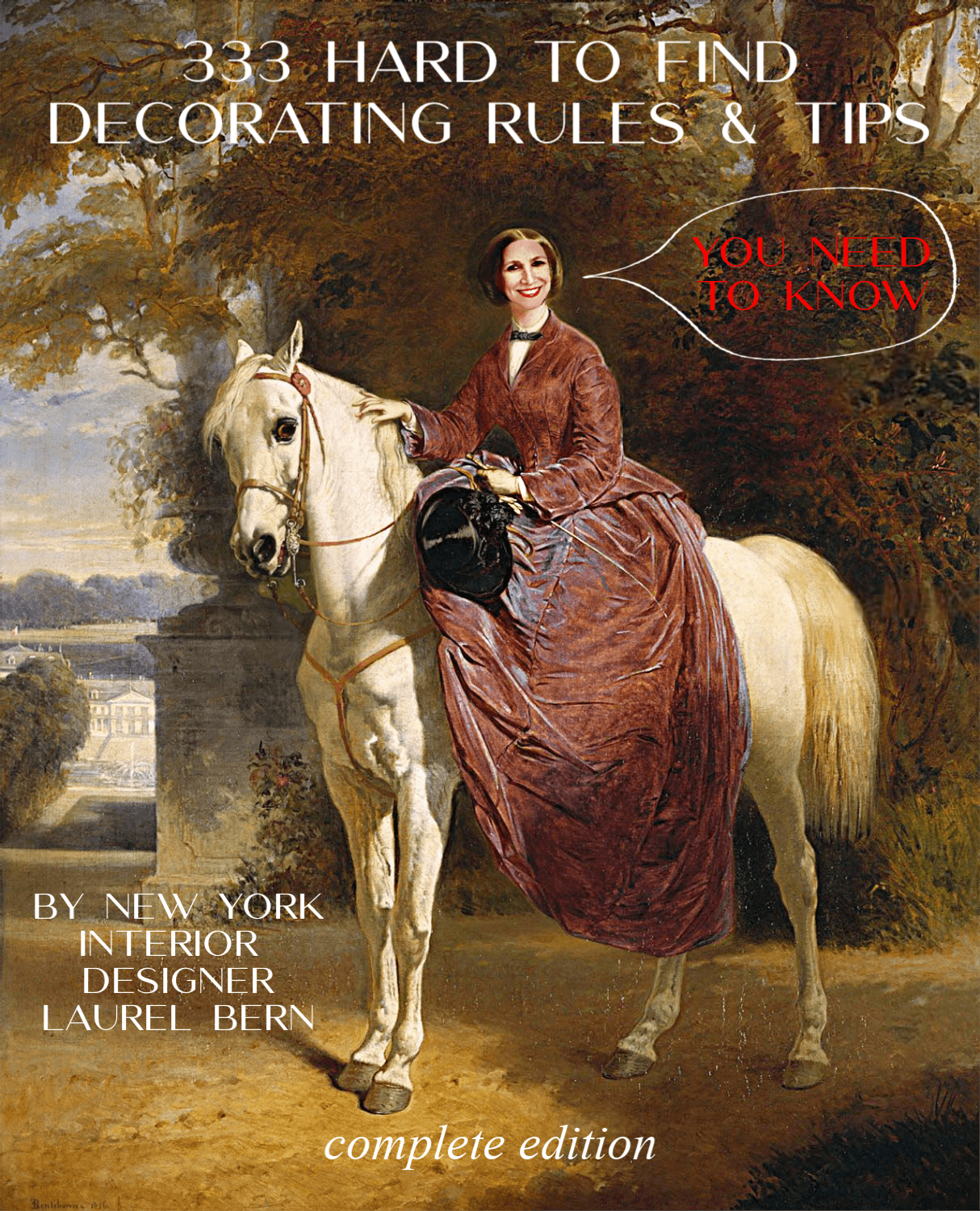
Guys, if you don’t have it, the 333 Decorating Rules & Tips (You Need to Know) has all these rules. Of course, I can’t think of every possible situation. I highly recommend you invest in this guide if you’re in the process or will be furnishing your home.
RULE: There should be a bare minimum of one foot of seagrass showing, but I prefer a minimum of 18″-24″ for the width.
There can be more seagrass showing for the length. It depends on how long the room is.
To be clear, the width is the short side of the rug. So, Let’s say your seagrass rug is 9 x 12, and you can see all four sides, then your oriental rug should be no greater than 7 x 10. But, a 5 x 8, is optimal. A 6 x 9 is okay too.
Let’s say your natural fiber rug is 13′ x 20′. (Note: many natural fiber rugs come in 13′ widths off the loom, so you can always do a rug this wide.)
This is a large rug. Let’s say this room is 15′ x 26′. You’ll have a one-foot margin for the width and three feet on the two ends, which is totally fine. However, let’s say you have a 5′ x 8′ area rug. It might work, or it might look too dinky. It all depends on your layout and why drawing out your floor plan is imperative!
More commonly, the oriental area rugs I did were 6 x 9 or 8 x 10.
Going back to the disaster $1,500 mistake, great room? Well, the finished size of the seagrass rugs was 18′ square. Yes, the room was square or nearly square. In this case, the oriental rug the client already owned was a family heirloom, a 9 x 12, which left a margin of 4.5′ on two sides and 3′ on two sides.
OMG! I just found a photo of it taken in 2002. The room was designed in 2000. So, this is what I was doing 23 years ago. But, before I show it to you. Please notice that there is no oriental rug. It was out at the cleaners the day I came to take pics! I didn’t even notice until I had been there for a while. It looked terrific, with or without the rug.
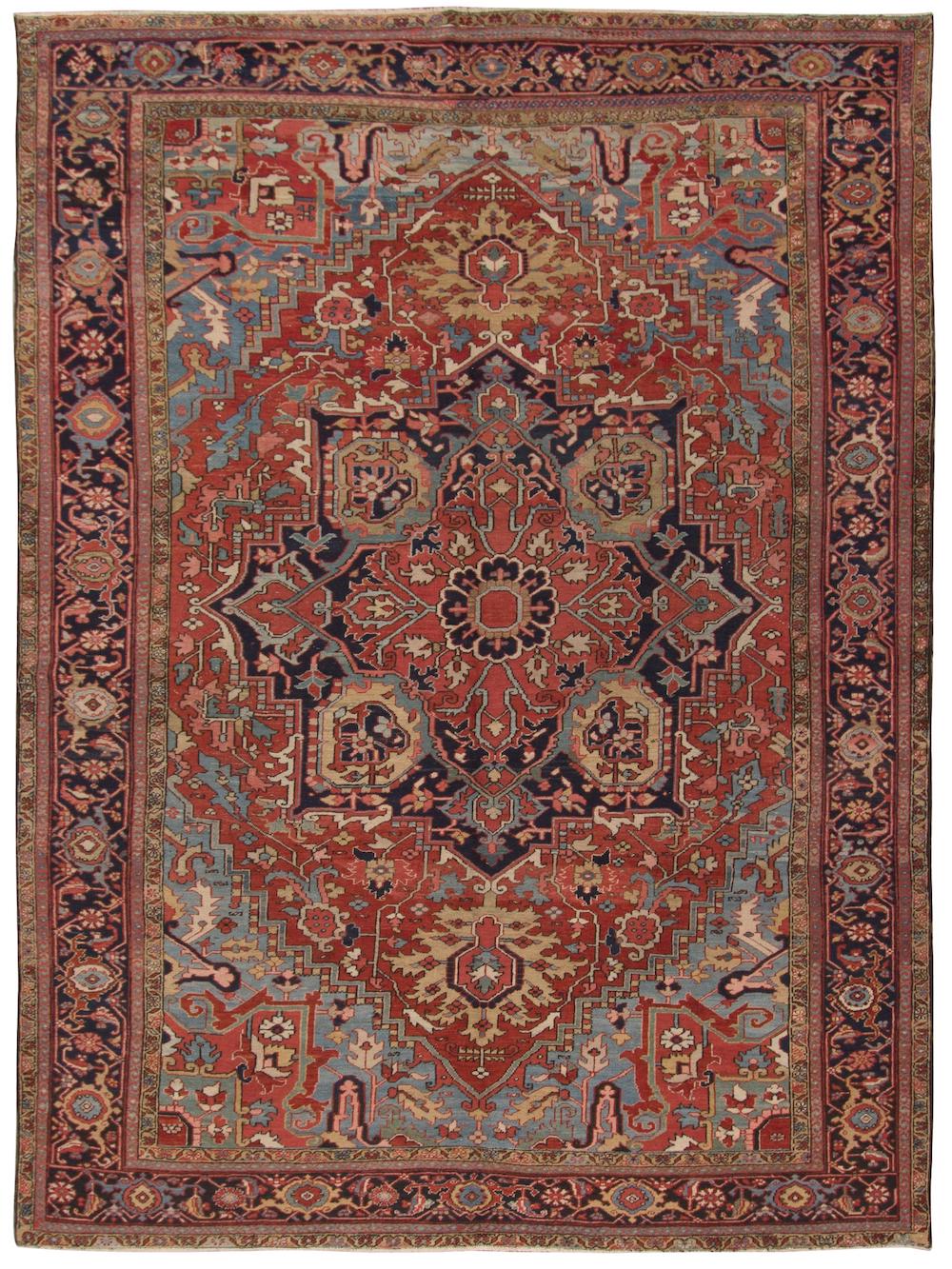
The rug was a classic Heriz with rusty reds and blues, a little beige, similar to the Heriz above currently available on 1stdibs. It’s not hellishly expensive, either.
Here’s the ancient pic that, at the time, I thought was so wonderful! I spent about 20 minutes getting it as clear as possible without special software that can do that.
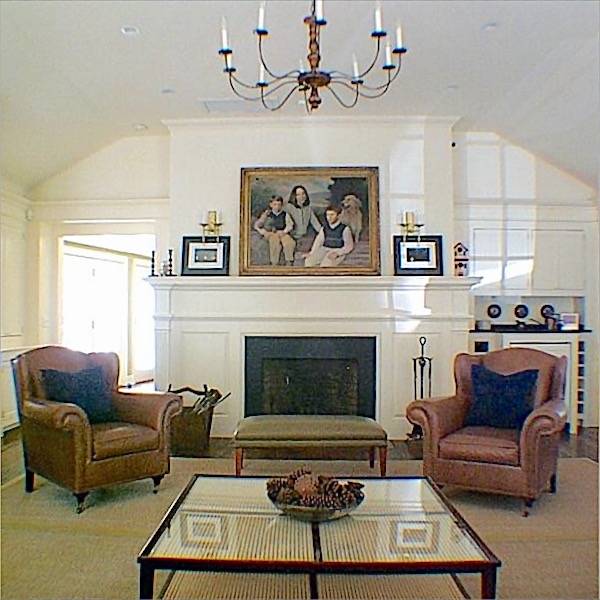
The coffee table doesn’t dip like that. lol, That’s from lens distortion. It was very cool. Yes, that’s glass over caning which is necessary. The legs were tapered with casters. The chairs were from Milling Rd., a division of Baker Furniture. I had the bench and pillows custom-made. That leather is that olive green that I got at Holly Hunt, NY.
The lighting is from Authentic Designs, a wonderful family-owned company in Vermont.
So, to sum up, the rules for layering an oriental rug over seagrass.
- The bare minimum margin needs to be at least one foot. But, it is better to be 18″-24″ or more.
- How much is too much of a margin?
It depends on what else is happening, but I don’t believe I’ve ever had more than six feet of the natural fiber rug showing in any direction.
Again, if you put it all on paper, it makes it easy to see if the proportions look good or not.
Below is a piece of graph paper. One square equals one square foot.

Use a straight edge or ruler. And, I love the retractable yellow pencils with erasers already on them.
OR, you can do what I’ve been doing. You can use your graph paper on picmonkey.com and do your floor plans as I do. Or, you can use a bonafide program designed to do floor plans. It matters, not the method. What matters is that you do it and do it to scale.
Below is the widget of beautiful rugs on the HOT SALES rug page. I’ve added nine area rugs. Some are from new sources.
For more information about any of them and to see them up close, please click on the individual images.

Speaking of sales.
The Serena & Lily sale ends at midnight, 3:00 AM eastern time.
Sorry, I tried to get this out ASAP.
Of course, there are many other fabulous sales going on. You can find out about some of them on the hot sales page.
Well, I’m sure there will be more questions concerning area rugs.
Fire away, but please, any questions need to be for the benefit of everyone.
Thanks so much!
xo,

Many thanks to many of you for clicking this Amazon link before making your Amazon purchases.
If you shop on Amazon, please click the link above before you put your items in your cart. The price is the same for you. The vendor pays me a small commission, which helps keep this blog running. I so appreciate your help! You can also click the banner below.
Related Posts
 How To Build A Unified Interior Color Palette
How To Build A Unified Interior Color Palette The Little Known Cure For Renovation Procrastination
The Little Known Cure For Renovation Procrastination Classic and Affordable Lamp and End Table Pairings
Classic and Affordable Lamp and End Table Pairings 22 Living Room Lighting Rules You Need To Know
22 Living Room Lighting Rules You Need To Know A Fall Color Interior Palette Inspired by McGrath II
A Fall Color Interior Palette Inspired by McGrath II Affordable Chinoiserie Murals & Panels + Sources!
Affordable Chinoiserie Murals & Panels + Sources! Bad Florida Architecture – A Tale of Two Homes
Bad Florida Architecture – A Tale of Two Homes











